Photographs can be evidence of history, tell a story, or convey a message. Some of them can also touch our hearts or influence our decisions in life.
Since photography was invented, millions of photos have been captured and printed. These days, you can now view photos from famous photographers, even those taken before you were born.
This article shows our 20 most famous photos of all time, including the interesting stories behind them. Most of them are iconic and influential, while some became controversial one way or the other.
Since there are hundreds of famous photographs out there, this list is not complete. Nevertheless, feel free to browse the list below.
Warning: Some photos contain graphic content that may be disturbing to some people, especially children.
Table of Content
20 Most Famous Photographs of All Time
1. Man on the Moon by Neil Armstrong (1969)
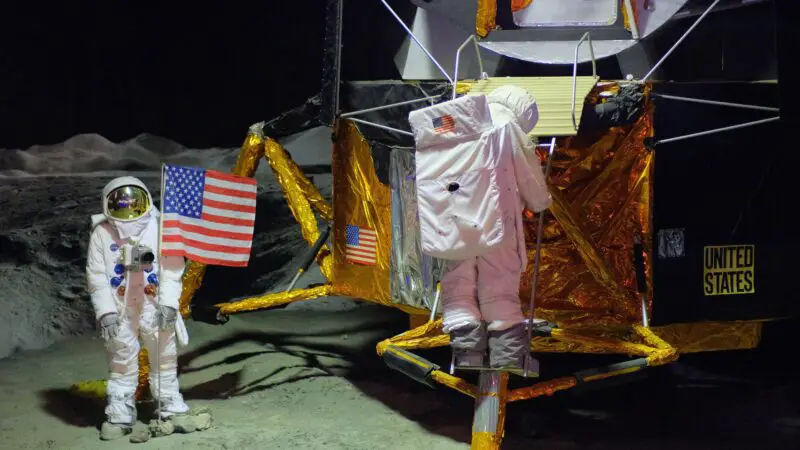
The iconic Man on the Moon photo was taken by Apollo 11 Commander Neil Armstrong on July 20, 1969. Although Armstrong was the first man on the moon, Buzz Aldrin (Edwin Eugene Aldrin Jr.) was the first man to have a photo on the moon. This Buzz Aldrin photograph on the moon is also by far the most famous photo of all time.
Armstrong stepped his foot on the moon at 10:56 pm (EDT) that day while the world was watching. He said, “That’s one small step for a man, one giant leap for mankind.”
Aldrin then joined him and the man on the moon photo was taken. Buzz Aldrin took a single photo of Neil Armstrong on the moon, but the latter was not facing the camera.
The Man on the Moon photo was taken using a 70-mm Hasselblad Data Camera (HDC) that was mounted on Armstrong’s suit. In the photo, Buzz Aldrin is seen standing in full body shot, and Neil Armstrong is reflected in his visor.
The success of the Apollo 11 mission made the US the winner of the space race against the Soviet Union during the Cold War.
2. Muhammad Ali vs. Sonny Liston by Neil Leifer (1965)
No products found.
The Muhammad Ali vs. Sonny Liston photo by Neil Leifer is probably the most famous sports photo of all time. This iconic photo was taken on May 25, 1965, during the second boxing match between the two great boxing legends, held at St. Dominic’s Arena in Lewiston, Maine. At that time, Leifer used a twin-lens reflex Rolleiflex film camera.
The first Ali vs. Liston fight (February 25, 1964) was very controversial and was named the fourth greatest sports moment of the 20th century by Sports Illustrated. Liston was then the champion, and Ali was the challenger.
Since Ali’s name at that time was still Cassius Clay, the match was advertised as a Liston-Clay fight. Clay won the fight.
Meanwhile, the famous Ali vs Liston photo was taken 1 minute and 44 seconds in the 1st round. Liston fell on the canvas after Ali gave him what has been dubbed a phantom punch and retained his crown.
Here, Ali was standing over Liston, and his right arm is at 90 degrees. Interestingly, it took several years before this photo became famous.
3. The Terror of War by Nick Ut (1972)
The Terror of War photo was taken by Associated Press (AP) photographer Nick Ut on June 8, 1972. At that time, he was assigned to cover the Vietnam War (1955-1975) and used a 35 mm Leica M2 rangefinder camera.
The following year, the famous photo (also known as the Napalm girl) won the Pulitzer Prize for Spot News Photography.
As you can see, the award-winning photo depicted children running away in fear on a road in Trang Bang. This is after a Napalm bomb was dropped in the area.
The highlight of the photo was the naked 9-year-old girl named Phan Thi Kim Phuc, whose clothes were burned, as well as her skin. Nick immediately brought her to the nearest hospital.
As expected, the Napalm girl photo was not initially allowed to be published due to nudity, especially of a young girl. Nevertheless, Horst Faas, a German photojournalist and Nick’s boss during that time, insisted on its publication. As for Phan Thi Kim Phuc, she eventually founded the Kim Foundation, which provides aid to child victims of war.
4. Guerrillero Heroico by Alberto Korda (1960)
- Amazon Kindle Edition
- Casey, Michael J. (Author)
- English (Publication Language)
The iconic Guerrillero Heroico photo was taken by Alberto Korda on March 5, 1960. Translated to English as Heroic Guerrilla Fighter, this famous Che Guevara photo was not shown in public until 1967. Ernesto “Che” Guevara is the Argentine Marxist revolutionary and diplomat who became a major figure during the Cuban Revolution.
Korda used a Leica M2 camera when he took the photo of Che Guevara. He later said that “the photograph is not the product of knowledge or technique. It was a coincidence, pure luck.”
The said photo was taken while the 31-year-old Guevara was attending the funeral for workers killed during a ship explosion in Havana, Cuba.
After Che Guevara was killed on October 9, 1967, in Bolivia, the Che Guevara photo appeared in the French magazine, Paris Match. Since then, it became one of the most famous photos of the 20th century and is one of the most reproduced photos of all time. This Che Guevara photo is now a fashion statement, appearing especially in T-shirts.
5. V-J Day in Times Square by Alfred Eisenstaedt (1945)
- Available in your choice of 4x6, 5x7, 8x10, 8.5x11, 13x19 and 17x22. Also some prints available in 24x36 and 40x60 (SIZING IN INCHES WITH BORDERS) (24x36 and 40x60 HAVE LARGER OVERALL CUTS)
- All images printed on PROFESSIONAL GRADE GLOSSY PHOTO PAPER
- Printed using UV resistant inks and professional printing process
The iconic V-J Day in Times Square photo was taken by Life photographer Alfred Eisenstaedt on August 14, 1945. The date was marked as Victory over Japan Day when then-US President Harry S. Truman announced in the White House that Imperial Japan had surrendered unconditionally, which effectively ended World War II (WW II).
Also known as V-J Day and the Kiss, this famous photo depicted an American soldier kissing a dental assistant, both were total strangers. Eisenstaedt used a Leica IIIa camera when he captured that bending kiss moment at around 5:51 p.m. ET. The iconic photo, along with other victory photos, was published in Life magazine a week later.
After decades of controversies, the sailor was said to be George Mendonsa, and the woman he kissed was Greta Zimmer Friedman. Interestingly, US Navy photojournalist Victor Jorgensen also took a photo of the same scenario, but it was less artistic. It was entitled “Kissing the War Goodbye,” which was published in the New York Times.
6. Saigon Execution by Eddie Adams (1968)
The disturbing Saigon Execution photo was taken by AP photographer Eddie Adams on February 1, 1968, at 252 Ngo Gia Tu Street, District 10, in Saigon (now Ho Chi Minh City).
The following year, Adams won the Pulitzer Prize for spot news photography for his photo. The said photo changed the course of the Vietnam War but haunted Adams.
In the photo, South Vietnamese Brigadier General Nguyen Ngọc Loan is seen shooting the head of Viet Cong Captain Nguyen Van Lem. After the shooting, Loan reportedly said, “These guys kill a lot of our people, and I think Buddha will forgive me.” Capt. Lem was said to be responsible for killing a South Vietnamese soldier and his entire family.
Adams, who was believed to have used a 35 mm Leica M4 rangefinder camera at that time, later apologized to Gen. Loan for taking and publishing the photo.
“The general killed the Viet Cong; I killed the general with my camera,” Adams wrote in 1998 in a Time magazine issue. After the war, Loan went to the US but was met with tons of criticism.
7. The Burning Monk by Malcolm Browne (1963)
- Wall Decor Prints: Buddhist Crisis 1963 Nbuddhist Monk Thich Quang Duc (1897-1963) Committing Self-Immolation At An Intersection In Saigon South Vietnam In Protest Against The Anti-Buddhist Measures Of President Ngo Dinh Diem And His Treatment Of Protestors 11 June 1963 Photographed By Malcolm Browne
- Model Number: GRC0176695LARGE
- Item Dimensions: 36.0 x 0.02 x 24.0
The Burning Monk photo was taken by American journalist and photographer Malcolm Browne on June 11, 1963. It served as a protest against the persecution of Buddhists during the administration of South Vietnamese president Ngo Dình Diem, a Catholic, and is backed up by the US. The disturbing photo won the World Press Photo of the Year.
The story started the day before when Vietnamese monks invited Browne and other reporters to witness a memorial service in Saigon the next day.
On the morning of June 11, at least 300 nuns and monks marched in the streets of Saigon. Shortly, 66-year-old Buddhist monk Thich Quang Duc emerged from a car along with two other monks.
Quang Duc sat down in the middle of the street, surrounded by nuns and other monks. Then, two young monks poured 5 gallons of gasoline on Quang Duc, who used a match to burn himself to death. Browne used a Petri camera in taking photos of the burning monk, who did not move and remained calm until his burnt-dead body fell to the ground.
8. The Vulture and the Little Girl by Kevin Carter (1993)
The Vulture and the Little Girl photo was taken by South African photojournalist Kevin Carter in 1993. It was first published in The New York Times on March 26th of the same year and won the Pulitzer Prize for Feature Photography award the following year. On July 27, 1994, Carter committed suicide after suffering from severe depression.
Earlier in 1993, Kevin Carter was invited to go to Sudan to take photos of the ongoing famine or extreme lack of food and other basic needs. While taking photos of famine victims in Ayod, in South Sudan, Carter saw a severely malnourished child slowly crawling to the United Nations feeding center. Shortly, a vulture suddenly appeared.
Advised not to touch famine victims due to their diseases, Carter did not help the toddler. Instead, he drove the vulture away after taking the photo. In his suicide note,
Carter said he has money problems and is “haunted by the vivid memories of killings and corpses.” Later, the child was identified as a boy named Kong Nyong, who survived the famine but died in 2007.
9. Mushroom Cloud Over Nagasaki by Lieutenant Charles Levy (1945)
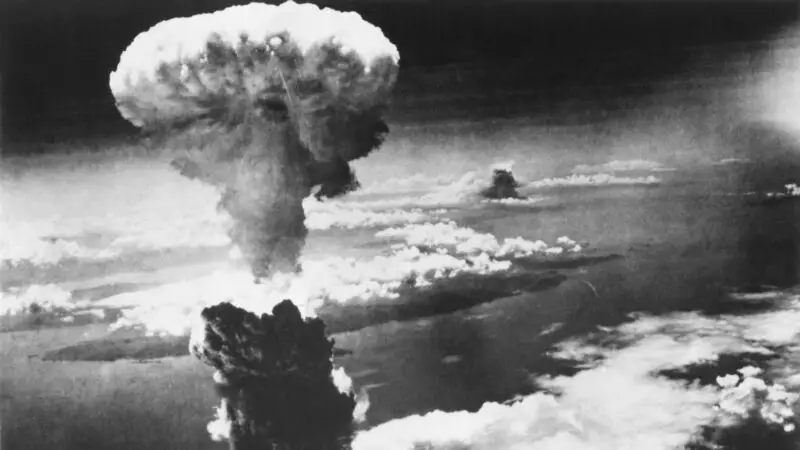
The Mushroom Cloud over Nagasaki photo was taken by Lieutenant Charles Levy on August 9, 1945, an unforgettable date in the history of mankind. This was the day when the Bockscar bomber dropped an atomic bomb named “Fat Man” at Nagasaki, Japan. It killed about 80,000 people, excluding those who died later due to radiation effects.
Lt. Levy was on board the B-29 aircraft “The Great Artiste” when he took 16 photos of the Nagasaki bombing using his personal 5×4” camera. He was supposed to board the Bockscar, but the crew switched planes at the last minute. Out of the photos, the one that showed a 45,000-foot-tall mushroom cloud was the only photo shown to the media.
Three days earlier, US forces dropped the “Little Boy” atomic bomb at Hiroshima, killing nearly 146,000 people. Before the bombings, the United States and its allies gave an ultimatum to Japan to surrender, but the latter ignored it. Japan was forced to surrender on August 15, 1945. The six-year World War II officially ended on September 2, 1945.
10. Lunch Atop A Skyscraper (1932)
- LUNCH ON A SKYSCRAPER CANVAS PRINT- Beautiful wall art that’s sure to get you in the holiday spirit, and brighten up the decor in your Home, Office, Living Room, Bedroom, Nursery & even Bathrooms!
- FRAMED & READY TO HANG. Built-To-Last Framed Bedroom Wall Art - Made with 18mm European pine frame & archival-grade canvas. Supplied Ready To Hang On a Nail In Your Wall.
- CAREFULLY HANDMADE - Each print is hand-made in the UK to ensure they last a lifetime.
The iconic Lunch Atop a Skyscraper photo was taken on September 20, 1932, as a publicity stunt to promote the RCA Building (now 30 Rockefeller Plaza) in New York City during the Great Depression.
That day, eleven construction workers of the said building were asked to sit on a steel beam 850 feet (260 meters) above the Big Apple.
Here, the 11 brave immigrant ironworkers are “eating their lunch” with Central Park in the background. This breathtaking stunt photo first appeared in the New York Herald-Tribune on October 2, 1932.
The identity of the photographer and the camera used remains unknown. Out of the 11 men in the photo, only three have been identified so far.
Nevertheless, three photographers took photos that day – Thomas Kelley, William Leftwich, and Charles Ebbets. According to the 2012 Irish documentary film, “Men at Lunch,” the first man from the right was Gusti Popovic from Slovakia. The third man from the right was Joe Curtis, while the third man from the left was Joseph Eckner.
11. Man Jumping the Puddle by Henri Cartier-Bresson (1932)
The famous 1932 photograph Man Jumping the Puddle by Henri Cartier-Bresson may look simple for ordinary people. As you can see, an unnamed man was captured in a photo jumping from a ladder on the water behind the Saint-Lazare train station in Paris, France. But for photo enthusiasts, this iconic image teaches a lot about photography.
Also known as ‘Behind the Gare Saint-Lazare,’ the Man Jumping the Puddle photo became a perfect symbol of being in the right place at the right time in photography.
As a renowned French Humanist photographer, Cartier-Bresson included this photograph in his 1952 photography book The Decisive Moment, which includes 126 stunning photos.
As the founder of modern photojournalism, Cartier-Bresson referred to the term “The Decisive Moment” as a moment when a photographer is “capturing an event that is ephemeral and spontaneous.”
He got the term from 17th-century Cardinal de Retz, who once wrote, “There is nothing in this world that does not have a decisive moment.”
12. Falling Man by Richard Drew (2001)
- Amazon Prime Video (Video on Demand)
- Henry Singer (Director) - Tom Junod (Writer) - Henry Singer (Producer)
- (Playback Language)
The famous but haunting Falling Man photo was taken by AP photographer Richard Drew on September 11, 2001. That day, America was under attack, which left a total of 2,997 deaths, including 19 terrorists.
Commonly known as 9/11, the September 11 attacks caused the World Trade Center twin towers in New York City to collapse.
That fateful morning, Drew was on an assignment at a maternity fashion show in Midtown when his office informed him about the attacks. Equipped with an early Nikon-Kodak hybrid digital camera, the Kodak DCS-620, Drew rushed to the scene and took as many photos as he could. Nonetheless, the Falling Man was his most iconic photo.
Drew had 8 or 9 frames of the falling man, but the most famous is the one with a vertical position of him. With his left leg bent at the knee, the falling man looks relaxed while falling to his death like an arrow. The identity of the falling man is still a mystery, but some journalists suggested that it could be Jonathan Briley or Norberto Hernandez.
13. Tank Man by Jeff Widener (1989)
The Tank Man photo was taken by AP photojournalist Jeff Widener on June 5, 1989. That day, he was on the balcony of the 6th floor of the Beijing Hotel.
Here, the man bravely stood in front of a column of four Type 59 tanks. The terrifying photo was a finalist in the 1990 Pulitzer Awards and is one of the most iconic photos of all time.
Days earlier, thousands of protestors gathered at Tiananmen Square and some other parts of the country. The Tiananmen Square protests started on April 15, 1989.
It was forcibly stopped on June 4th of the same year after the Chinese government declared martial law. Freedom of speech was restricted, and media control was tightened.
Widener used a Nikon FE2 film camera when he took photos of the Tank Man. Feeling sick and running out of films, he was assisted by an American college student named Kirk Martsen. The name of the Tank Man was never known. Although he was moved away from the front of the tank, no one knows what happened to him afterward.
14. The Roaring Lion by Yousuf Karsh (1941)
- Amazon Prime Video (Video on Demand)
- Ben Kingsley, Bryan McArdle, Doron Avraham (Actors)
- Richard Trank (Director) - Marvin Hier (Writer) - Richard Trank (Producer)
The famous Roaring Lion photo was taken by Armenian-Canadian photographer Yousuf Karsh on December 30, 1941, in the House of Commons at the Parliament of Canada in Ottawa.
The iconic Winston Churchill portrait photograph shows the then 67-year-old British prime minister without his iconic cigar and wearing a seemingly angry face.
Interestingly, Winston Churchill was not informed that Karsh was assigned to take a photo of him. The photographer politely requested him to remove the cigar from his mouth because the smoke would affect the image quality. The prime minister reluctantly agreed and said, “You can even make a roaring lion stand still to be photographed.”
This Winston Churchill photo, which Karsh was believed to have used a Calumet C1 8×10 camera, is one of the most famous political images of the 20th century. This is because it was taken shortly after the British wartime minister delivered his historical “Some chicken! Some neck!” speech. It can also be seen in £5 banknotes since 2013.
15. Migrant Mother by Dorothea Lange (1936)
- English (Publication Language)
- 47 Pages - 04/23/2019 (Publication Date) - The Museum of Modern Art, New York (Publisher)
The famous Migrant Mother photo was taken by American documentary photographer Dorothea Lange in March 1936. The image depicted a mother gazing into the distance while carrying an infant, with two older children standing on each side of their mother and hiding their faces. It eventually became an iconic symbol of the Great Depression.
As recalled by Lange, she was driving on a rainy afternoon in Nipomo, California when she passed by a camp with out-of-work migrant pea pickers. Being a photographer for the Resettlement Administration, (a federal government agency that relocated struggling urban and rural families), she took several photos of the woman from different angles.
Lance asked the woman’s permission to take photos of her, but she did not ask for her name. Nonetheless, she learned that the mother is 32 years old, has seven children, and has been living on frozen vegetables.
The iconic photo was shot using a 4×5” Graflex camera. In 1978, the woman was identified as Florence Owens Thompson.
16. Afghan Girl by Steve McCurry (1984)
No products found.
The iconic Afghan Girl photo was taken by National Geographic Society photographer Steve McCurry sometime in December 1984. It was published on the cover page of National Geographic magazine the following year.
Then, it became the most famous photo in the magazine’s history. Yet, it also became a subject of controversies and criticisms.
The Afghan Girl photo was taken using a Nikon FM2 camera with a Nikkor 105mm Ai-S F2.5 lens. The girl in the photo was identified as a 12-year-old Pashtun orphan spotted by McCurry at Nasir Bagh refugee camp on the Afghan-Pakistan border, also called the Durand Line. She was wearing a red burqa, with her green eyes staring at the camera.
However, it was only in 2002 that a National Geographic team learned that the Afghan Girl’s name was Sharbat Gula. This is after they found her in Afghanistan and took photos of her again.
During the interview, Gula admitted that she got angry after learning that her younger photo was published without her consent or by her father.
17. Fire Escape Collapse by Stanley Forman (1975)
The famous (and infamous) Fire Escape Collapse photo was taken by Stanley Forman on July 22, 1975. At that time, the American photojournalist was working for the daily newspaper, Boston Herald American.
Despite the criticisms, it won the World Press Photo of the Year and the Pulitzer Prize for Spot News Photography the following year.
Armed with a motor-drive camera, Forman was informed about a burning apartment on Marlborough Street in Boston, Massachusetts. When he arrived at the scene, 19-year-old Diana Bryant and her 2-year-old goddaughter Tiare Jones were at the fire escape on the 5thh floor of the building. That time, firefighters were trying to rescue them.
A firefighter named Robert O’Neill, who was on the roof, asked Bryant to give the child to him. But because she could not do so, he jumped to the fire exit while waiting for the ladder.
However, the fire escape collapsed, and Diana and Tiare fell to the ground. The child landed on Diana’s body and survived, but her godmother died in the hospital.
18. View From The Window At Le Gras by Joseph Nicéphore Niépce (1826)
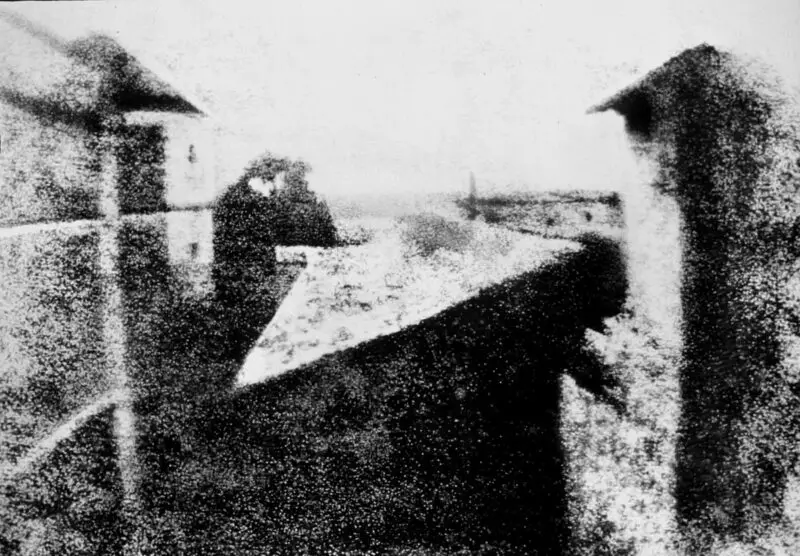
The iconic View from the Window at Le Gras photo was created by French inventor Joseph Nicephore Niepce in 1826 or 1827. At first glance, you may not find anything extraordinary. Yet, this famous image is known for being the world’s first photograph. Although a scientist, Nicephore Niepce is considered the world’s first photographer.
During this period, the term “photography” did not exist yet. To create the image, Niepce used a camera obscura (Latin term for “dark room”). It is a wooden box treated with a heated pewter plate and light-sensitive materials. It has a small hole that serves as the lens. He left it open for at least eight hours and used sunlight to project the image.
Niepce placed the camera obscura (also called the pinhole camera) on his second-story house, facing out the window of his Le Gras estate in France, thus capturing the image outside.
He called the process “heliography” and worked with inventor Louis-Jacques-Mandé Daguerre to improve the process. This led to what we now call photography.
19. Pillars of Creation by Hubble Space Telescope (1995)
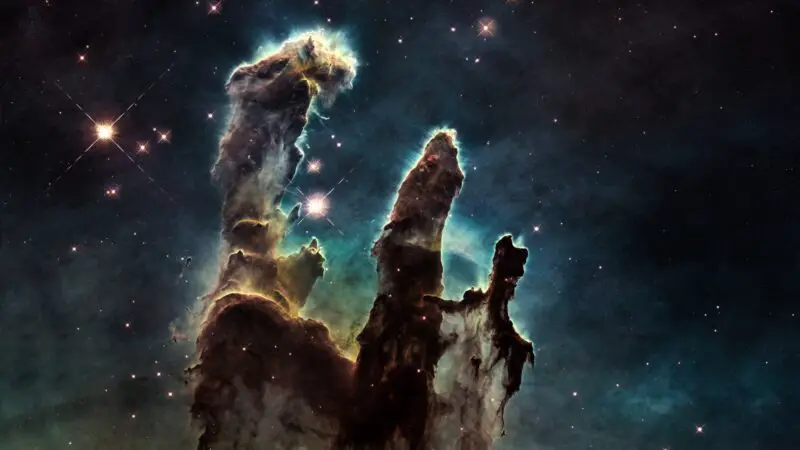
The stunning Pillars of Creation photograph in the Eagle Nebula (Messier 16) was taken by the Hubble Space Telescope of the National Aeronautics and Space Administration (NASA) on April 1, 1995.
This ever-famous photo was shot by astronomers Jeff Hester and Paul Scowen using Hubble’s Wide-Field Planetary Camera 2 (WFPC2).
The Pillars of Creation are composed of three towers of gas and cosmic dust that are parts of an active star-forming region in the Messier 16. The green represents both nitrogen and hydrogen, the red represents sulfur, and the blue is oxygen. Its size is about 4 to 5 light-years. One light-year is approximately 9 trillion km (6 trillion miles).
In 2014, the Pillars of Creation was revisited by the Hubble Space Telescope. The camera used was the Wide Field Camera 3, which replaced the WFPC2.
On August 14, 2022, a photo of the Pillars of Creation was taken again. This time, astronomers used the Near-Infrared Camera (NIRCam) of NASA’s James Webb Space Telescope (JWST).
20. Loch Ness Monster by Robert Kenneth Wilson (1934)
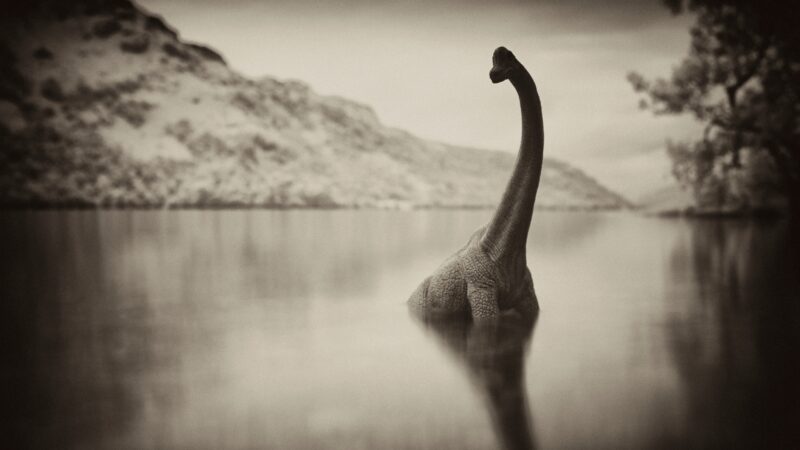
The story about the supposed Loch Ness monster started back in the year 564. To this date, several people have claimed to have seen the mythical sea monster.
But so far, the supposed photo of the Loch Ness monster (commonly called Nessie) taken by a general surgeon named Robert Kenneth Wilson in 1934 is the most famous of them all.
That time, Wilson was on a fishing trip in Scotland with a friend. He claimed that he had taken two photos of the Loch Ness monster. Being the first photo of the ‘Loch Ness monster’ with a head and neck, the Daily Mail published it on April 21, 1934. But since Wilson did not want to be involved, the image was called the “Surgeon’s Photograph.”
But in 1993, this Loch Ness monster photo was confirmed to be a hoax. It was taken by Marmaduke Wetherell. The “creature” was a toy submarine built by his son-in-law, Christian Spurling.
To get revenge on the newspaper after he was publicly humiliated for his Loch Ness monster footprints hoax, Wetherell collaborated with Spurling and Wilson.









